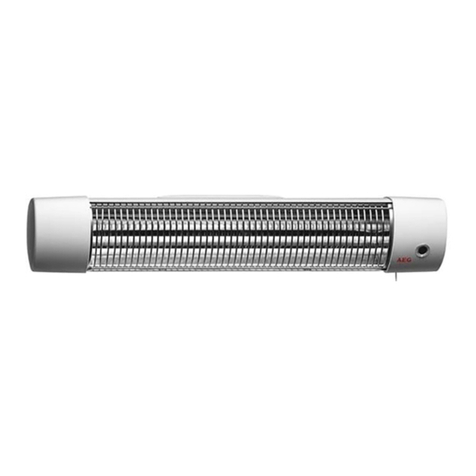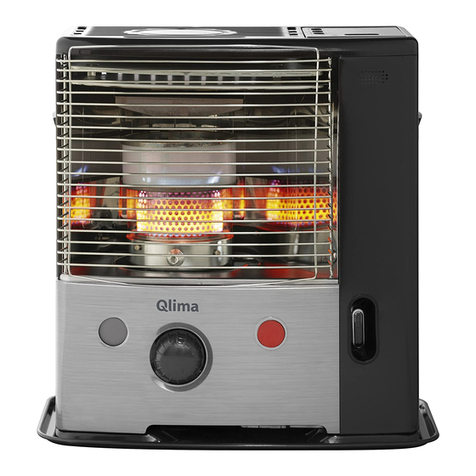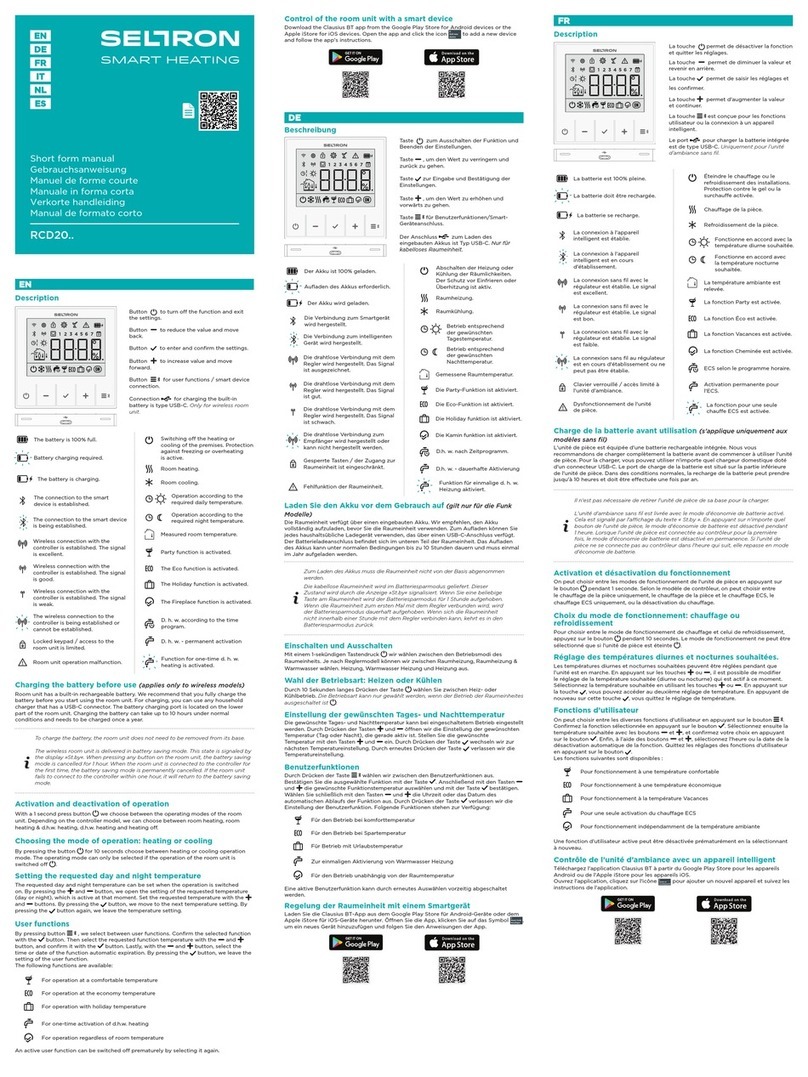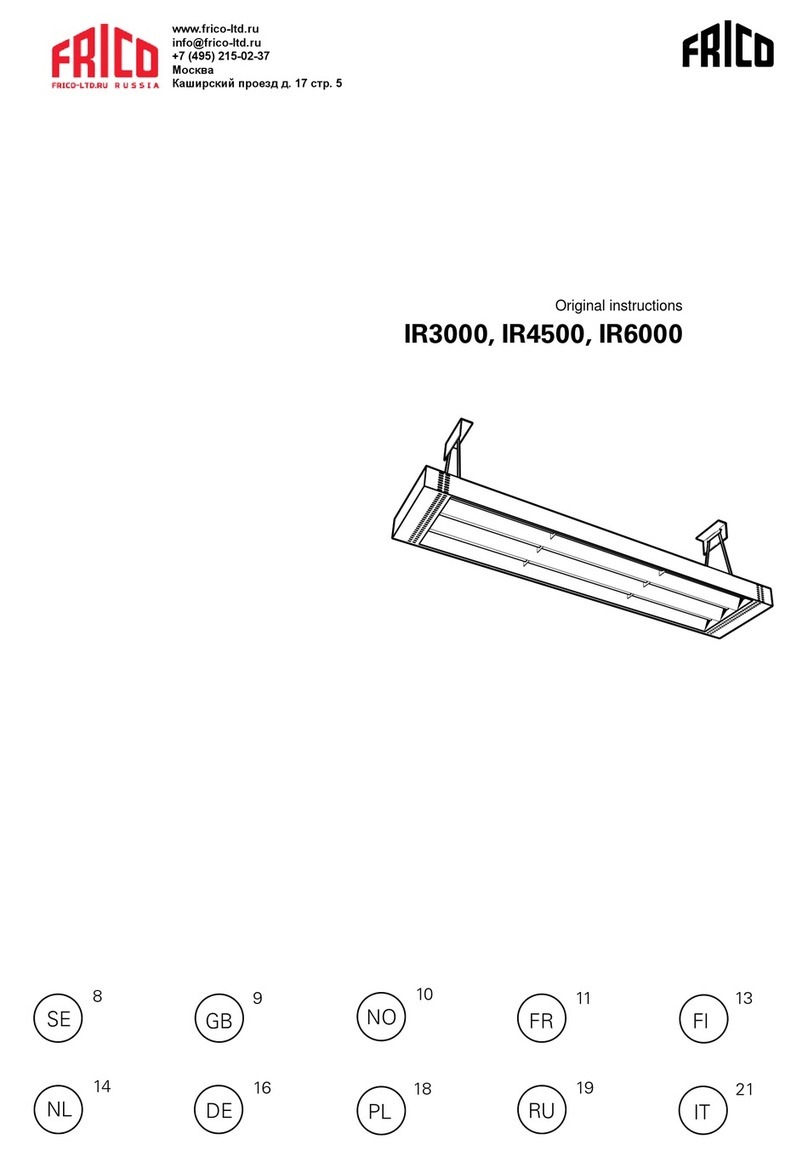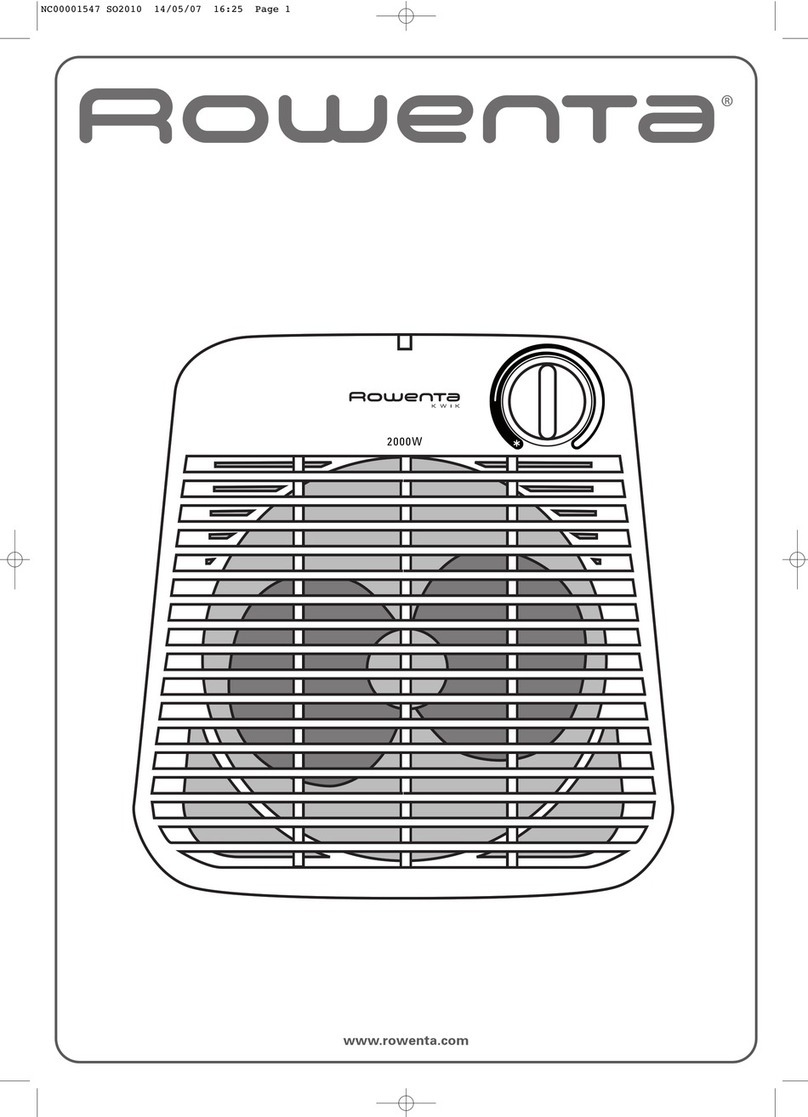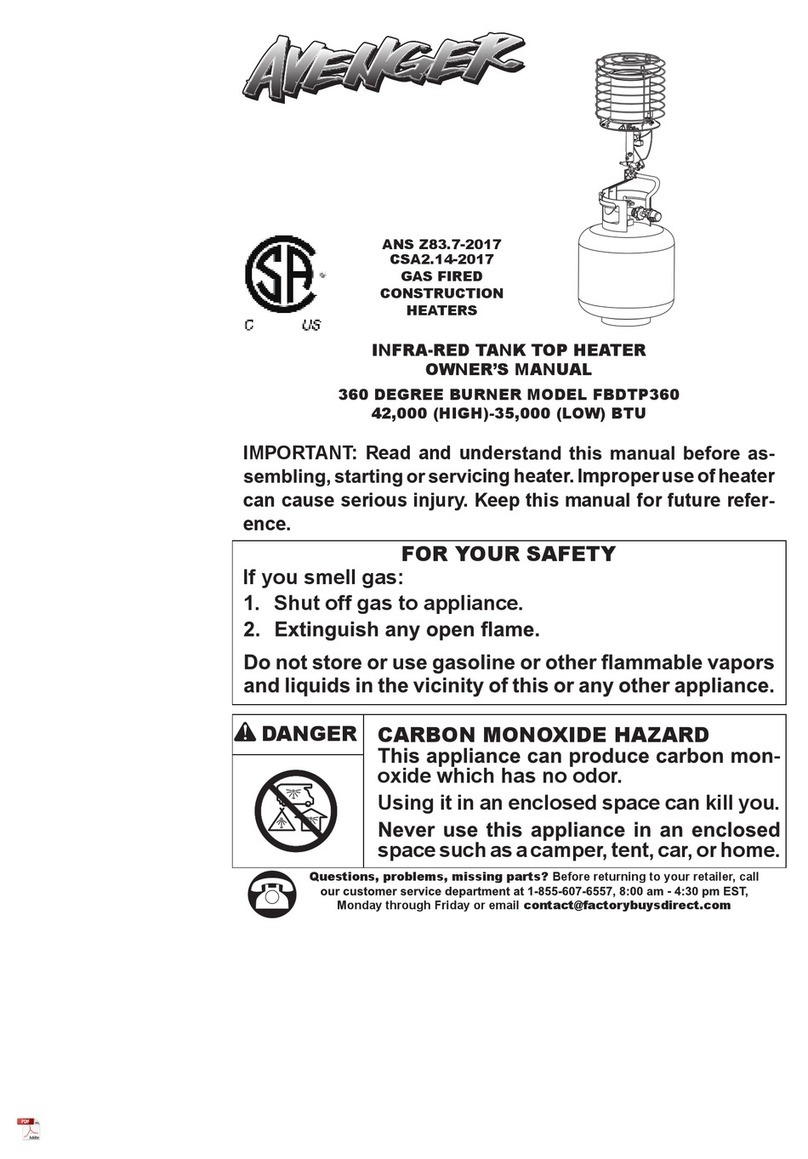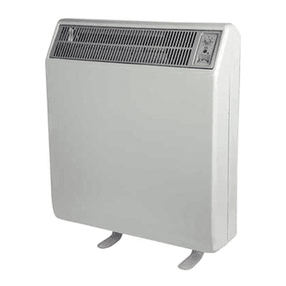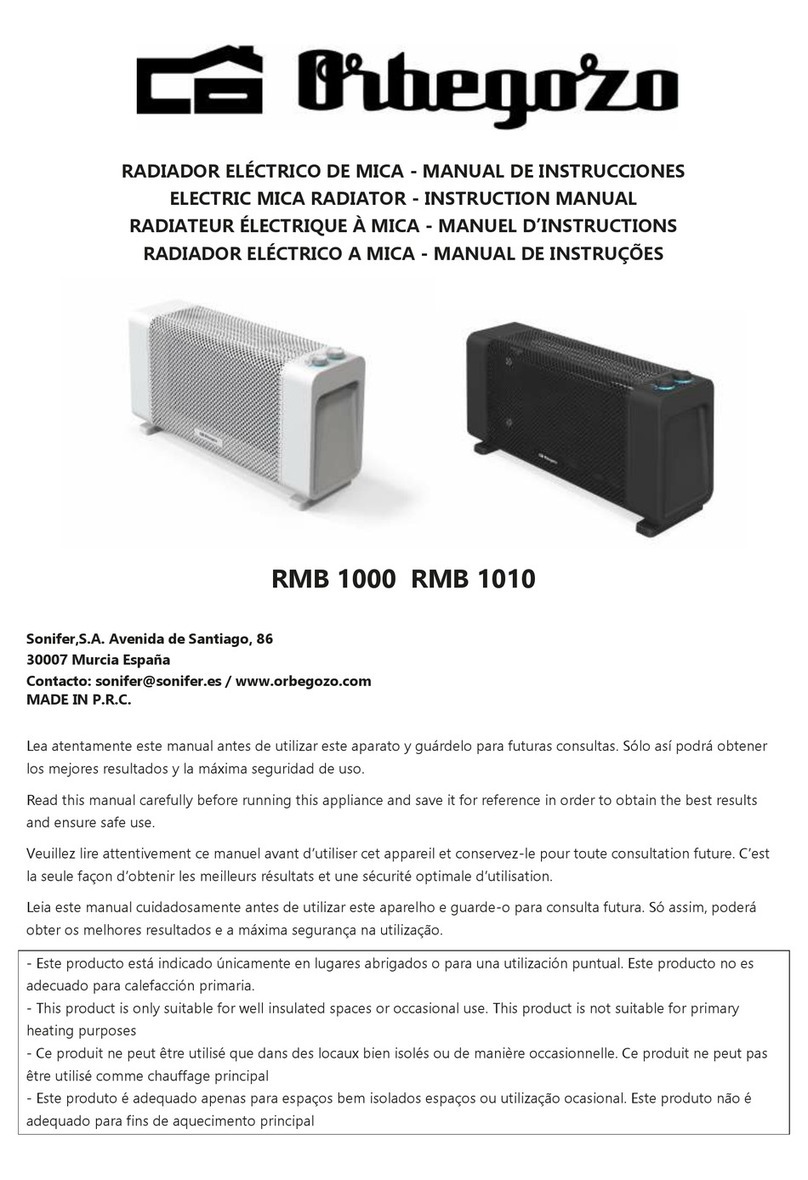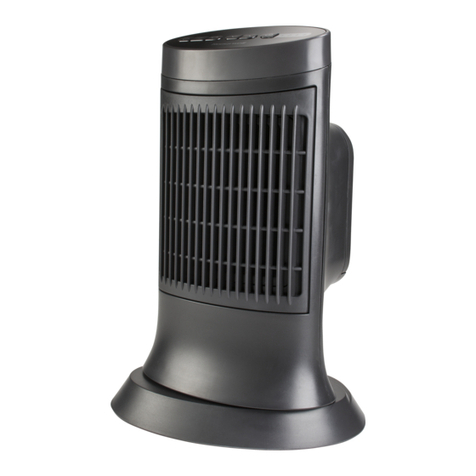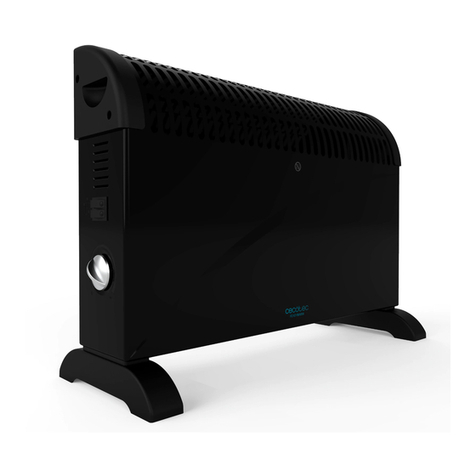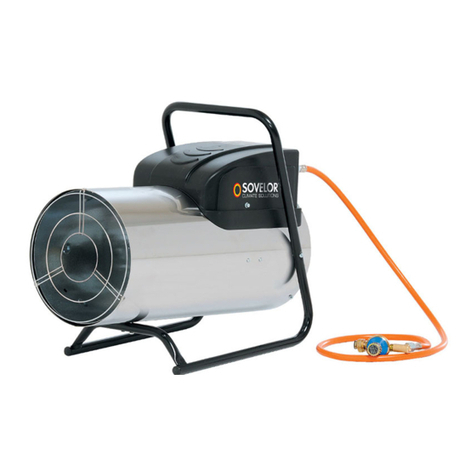MALUX AW Series User manual

AW 12s-62s, 12a-62a
SE MANUAL FÖR VÄRMEFLÄKT VATTEN
VIKTIGT: Läs denna anvisning innan produkten installeras och används.
Spara anvisningen för framtida bruk ...................................................................................... 2
GB MANUAL FOR FAN HEATER UNIT, WATER
IMPORTANT: Read these instructions before the product is installed and used.
Save the instructions for future use .............................................................................. 11
DE HANDBUCH FÜR LUFTERHITZER, WASSER
WICHTIG: Lesen Sie diese Anleitung durch, bevor Sie das Gerät installieren und in Betrieb nehmen.
Verwahren Sie die Montageanleitung fûr den späteren Gebrauch ................................ 21

AW 12s-62s, 12a-62a
2
Användning
Denna apparat får användas av barn över 8 år, personer med fysiska- eller psykiska funktionshinder samt
personer som saknar erfarenhet, men endast under förutsättning att de har fått noggranna instruktioner om
apparatens funktioner och eventuella risker. Barn får ej leka med apparaten. Rengöring och underhåll får ej
utföras av barn utan att de har tillsyn. Barn under tre år ska inte vara i närheten utan ständig tillsyn.
Barn mellan tre och åtta år får endast sätta på/stänga av apparaten om den står på lämplig plats och de har fått
instruktioner om tillvägagångssätt eller har tillsyn. De ska också informeras om möjliga faror.
Barn i åldern tre till åtta år får inte sätta i kontakten, ändra inställningar eller utföra skötsel/underhåll.
VARNING – Delar av denna apparat kan bli varma och orsaka brännskador.
Barn och sårbara personer ska hållas under uppsikt.
Värmeäkten nns i fyra storlekar AW 12, AW 22, AW 42 och AW 62.
Samtliga modeller har som standard tre äktvarvtal. Värmeäkten är i kappslingsklass IP44 och får installeras i torra,
fuktiga och våta rum. Modell AW-a levereras med ventil. Tekniska data på värmeäktarna, se bilaga A.
AW 12s, -22s, -42s, -62s.
Dessa värmeäktar har ingen inbyggd reglering. Styrningen av äktmotor och vatten löses medexterna komponenter.
I lokaler där frostrisk föreligger skall frysskydd installeras.
AW 12a, -22a, -42a, -62a.
Värmeäkten har inbyggd reglering och används där frysrisk ej föreligger. I värmeäkten nns en elektronisk tre-
stegstermostat som reglerar äktens varvtal i tre steg efter rådande värmebehov. Termostaten arbetar med intermittent
äktdrift, dvs. även äktmotor stannar när inget värmebehov nns. Detta medför att nedsmutsningen av vattenbatteri
och eventuella lter minimeras. Även varvtalsregleringen som håller äkten på lägsta möjliga luftmängd minskar
nedsmutsningen. Trestegsregleringen medför också att värmeäkten stora delar av året klarar sig på de lägre varvtalen
och man får därför en låg ljudnivå. Vattenödet regleras on/o av en ventil med påbyggt ställdon.
Öppnings- resp. stängningstid är 15 sek. Ventilen öppnar samtidigt som äkten startar på lågvarv.
Till regleringen behövs en rumsgivare med börvärdesinställare (TG-R430) eller rumsgivare (TG-R530 eller TG-R630)
med separat börvärdesinställare (TG-R430). Stegdierens på termostaten är 1°C.
Som alternativ till TG-givare kan en extern 0... 10V DC styrsignal kopplas till den elektroniska termostaten.
AW-a har också en utgående styrsignal. Denna funktion nns oberoende om man använder TG-givare eller inkom-
mande 0... 10V DC styrsignal. Den utgående styrsignalen kan slavstyra upp till fem andra AW-a eller CAW-a.
(CAW-a är VEABs serie av takmonterade värmeäktar). Vill man slavstyra er än 5st värmeäktar från gemensam
givare eller 0... 10V DC styrsignal använder man utgånde styrsignal från en slavstyrd AW-a.
Exempel på inkoppling av givare eller styrsignal nns på bilaga G,H, I och K i denna folder.
SE
Tillbehör AW a-s (se bilaga B)
Filter AWPF.
Planlter för montage i AW12-62 mellan äkt
och vattenbatteri.
Luftriktare AWLH.
På värmeäkten sitter som standard alltid en luftriktare
som riktar luften snett nedåt. Som tillbehör nns
luftriktare AWLH som riktar luften i sidled.
Luftaccelerator AWLA
Förlänger kastlängden med i snitt 40%.
Kan ej användas tillsammans med AWLH.
Monteras enl. separat anvisning.
Väggkonsol AWV.
Användes för montage av värmeäkten på vägg eller
montage i taket med vertikal luftström.
Takkonsol AWT.
Användes för montage av värmeäkten i tak med
horisontell luftström.
Kan även användas ihop med väggkonsol.

AW 12s-62s, 12a-62a
3
Montering av lter AWPF.
1. Lossa rengöringsluckan på sidan.
2. För in ltret genom öppningen med äderdelen mot dig enl. bild 1.
3. Placera ltrets äderdel på vattenbatteriets plåtkant, tryck ltret mot kopplingsskåpet och mot vattenbatteriet så
att ltrets U-prol greppar på vattenbatteriets bortre kant, se bild 2.
Luftriktare för luft i sidled AWLH.
1. Montera luftriktaren på värmeäkten med plåtskruv enl. bild 3 och 4.
Justera luftriktarbladen så att önskad luftriktning erhålles.
Montering av väggkonsol AWV.
1. Lossa de åtta skruvarna som markerats med pilar enl. bild 5.
2. Montera konsolerna enl. bild 6.
Bild 5 Bild 6
Bild 1 Bild 2
Bild 3 Bild 4

AW 12s-62s, 12a-62a
4
3. Värmeäkten kan monteras med rören åt vänster eller höger framifrån sett enl. bild 7 och 8.
I lokaler med hög takhöjd bör värmeäkten monteras lågt, dock utan att störa arbetsmiljön. Borrmall för
värmeäktarnas väggkonsol med minavstånd till golv, tak respektive vägg, se bilaga C.
4. Värmeäktarna levereras med luftriktaren monterad för montage enl. bild 7. Om värmeäkten monteras med
rören åt höger måste luftriktaren vändas om luften skall riktas nedåt. Lossa de sex skruvarna som håller
luftriktaren enl. bild 9 och tag ut luftriktaren och vrid den ett halvt varv. Skruva därefter fast den igen.
5. Vid montering i tak för vertikal luftström monteras värmeäkten enl. bild 10. Minsta avstånd till vägg bör vara
700 mm. Om värmaren monteras i tak nära ett vägghörn, bör minsta avståndet till ena väggen vara 700 mm och
andra väggen minst 2000 mm.
Montering av takkonsoler AWT.
1. Lossa plåtskruvarna på värmeäkten enl. bild 11 (på AW 42 och AW 62 fyra skruvar).
2. Montera takkonsolerna enl. bild 12.
Bild 7 Bild 8
Bild 9 Bild 10
Bild 11 Bild 12

AW 12s-62s, 12a-62a
5
3. Montera värmeäkt med takkonsoler i taket enl. bild 13 och 14.
4. Minsta avstånd från värmeäktens bakkant till vägg (pil bild 13) på AW 12 och AW 22 är 200mm.
På AW 42 och 62 är minavståndet 270mm.
5. Minsta avstånd från värmeäktens sida till vägg (pil bild 14) är 700mm.
Vattenanslutning av AW-s och AW-a.
VARNING! Kontrollera noga att hela systemet är tätt efter vattenanslutningen.
Eventuellt läckage kan förorsaka dyrbara vattenskador.
1. Värmeäkten får ej anslutas till tappvarmvatten eller ånga. Högsta tillåtna temperatur och tryck är angivet på
värmeäktens typskylt vid anslutningsrören.
2. Kapacitet, vattentemperatur, öde och tryckfall kan utläsas i tabell för resp. storlek, se bilaga D.
3. Värmeäkten skall anslutas så att man vid driftsstopp när frysrisk föreligger, kan tömma batteriet på vatten.
4. Vid värmeäktens utloppsrör eller centralt i anläggningen monteras avluftningsventil.
5. Vid återdragning av klämringskopplingar på anslutningsrör eller ventiler skall dessa hållas fast, så att vridkraft ej
överförs till värmeäktens in- och utloppsrör.
6. Anslutet rörsystem till värmeäkten måste xeras så att de ej belastar äktens in- och utloppsrör.
7. Vatteninloppet ansluts på värmarens lägst placerade rör och utloppet på det högst placerade enl. pilar bild 15.
Anslutningen på AW 12- AW 22 är Ø 22mm och på AW 42- AW 62 Ø 28mm.
Anslutning med hjälp av presskoppling eller klämringskoppling rekommenderas.
Om röranslutningen skall lödas, måste röret innanför lödstället kylas (med exempelvis våt trasa, kylbackar eller
trycklyft) så att packningen innanför plåten (pil A bild 16) ej blir varmare än 100°C.
Tag bort stödhylsan innan lödning för att minska värmebehovet.
8. Vid anslutning med presskoppling eller klämringskoppling skall stödhylsa användas pga. att kopparrören är
mjukglödgade. Kontrollera att istoppad stödhylsa sitter i enl. pil B bild 16.
Montera kopplingarna enl. tillverkarens anvisningar.
Bild 13 Bild 14
B
A
Bild 15 Bild 16

AW 12s-62s, 12a-62a
6
9. På AW-a modellerna bör medföljande ventil (tillbehör på AW-s) monteras på det översta röret (utloppet), för att
få lägsta temperaturen på ventilen enl. bild 17. Ventilen skall monteras horisontalt med oberoende ödesriktning.
Anslutningen till ställdonet riktas rakt upp för att ställdonets IP-klassning ska bibehållas.
Drag åt ventilens klämringskopplingarna för hand och sedan 1 varv. Lossa därefter muttern ¼ varv för att avlasta
kopplingen från spänningar. Dra åter muttern så att kopplingen blir tät.
För mer information om ventilen, se monteringsanvisning som följer med ventilen.
Bild 17

AW 12s-62s, 12a-62a
7
Elanslutning AW-s modeller.
1. Installationen skall utföras av behörig installatör.
2. Värmeäkten är utförd för 230V växelström.
3. Elanslutning till nätet skall göras med fast förlagd kabel. Allpolig brytning med brytavstånd på minst 3 mm skall
ordnas i den fasta installationen.
4. Lossa locket till kopplingsskåpet enl. bild 18.
5. Inkoppling av värmeäkt och val av varvtal görs enl. bifogat kopplingsschema i locket, se bild 19 eller bilaga E.
6. Tag bort det antal kabelintag som behövs för installationen med hjälp av en spetsig skruvmejsel och hammare
enl. bild 20. Bryt bort brickan med en tång enl. bild 21.
7. Termostaten som skall styra värmeäkten, bör monteras så att den ej påverkas av drag från dörrar och fönster som
öppnas, värmeäktens utblåsningsluft eller dyl.
Elanslutning av originaltillbehör för AW-s modeller.
1. Termostat R31 (bild 22) med temperaturområde 7-30°C och skyddsform IP20.
En termostat kan styra en AW-s värmare.
2. Termostat SR121/1 (bild 23) med temperaturområde 0-40°C och skyddsform IP54.
En termostat kan styra max två AW-s värmare.
Bild 18 Bild 19
Bild 20 Bild 21
Bild 22 R31 Bild 23 SR121/1

AW 12s-62s, 12a-62a
8
3. Varvtalsomkopplare AWC 12-62 med tre varvtal (bild 24) som väljs manuellt.
1 = lågvarv, 2 = mellanvarv och 3 = högvarv. Skyddsform IP 65.
Kan styra max 2 st AW-s värmare. Kopplingsschema se bilaga F.
OBS! Om termostat R31 eller SR121/1 används kan max en resp. två AW-s värmare kopplas in.
4. Ventil med kapslingsklass IP44 (bild 25), max vattentemperatur 90°C och tryckklass PN25 (25 bar).
Används tillsammans med termostat R31, SR121/1.
Mer information nns under ”Vattenanslutning av AW-s och AW-a” punkt 9.
Elanslutning AW-a modeller
1. Installationen skall utföras av behörig installatör.
2. Värmeäkten är utförd för 230V växelström.
3. Elanslutning till nätet skall göras med fast förlagd kabel. Allpolig brytning med brytavstånd på minst 3 mm skall
ordnas i den fasta installationen.
4. Lossa locket till kopplingsskåpet enl. bild 18 under rubriken ” Elanslutning AW-s ..”
5. Inkoppling av värmeäkt görs enl. bifogat kopplingsschema i locket eller bilaga G.
Om AW-a värmaren skall slavstyra en eller era AW-a eller CAW-a (CAW-a är VEAB:s serie av takmonterade
värmeäktar) sker inkoppling enl. bilaga H, I och K.
Bild 24 AWC 12-62 Bild 25

AW 12s-62s, 12a-62a
9
6. Till den inbyggda elektroniska termostaten i AW-a, ansluts en rumsgivare med börvärdesinställare
TG-R430 (se bild 26) som har skyddsform IP 30. Rumsgivaren/börvärdesinställaren bör monteras så att den ej
påverkas av drag från dörrar och fönster som öppnas, värmeäktens utblåsningsluft eller dyl.
Om man vill ha separat rumsgivare, väljer man TG-R530 (se bild 27) och monterar sedan börvärdesinställaren
TG-R 430 på annan plats. Behövs högre skyddsform på givaren väljer man TG-R630 (se bild 28)
som har skyddsform IP 54 och monterar börvärdesinställaren i en plastkapsling med motsvarande skyddsform.
7. Tag bort det antal kabelintag som behövs för installationen med hjälp en spetsig skruvmejsel och hammare enl.
bild 29. Bryt bort brickan med en tång enl. bild 30.
Rengöring
För att erhålla optimal funktion måste värmeäkten rengöras regelbundet.
Dammbeläggning på vattenbatteriets aluminiumlameller minskar luftödet och försämrar värme-överföringen.
Batterietmåste därför hållas rent, vilket kan ske med hjälp av nedanstående alternativ:
1. Renblåsning med tryckluft
2. Renblåsning med ånga
3. Spolning eller sköljning med vatten. Vid fettbelagda lameller tillsätt lämpligt tvättmedel.
I alternativ 2 och 3 skall äktmotorerna skyddas mot vatten. Vid rengöring skall värmeäkten göras spänningslös,
luftriktare och rengöringslucka tas bort.
Rengör även äktens skyddsgaller och äktvinge med en mjuk borste.
Tidsintervallerna mellan varje rengöring beror på vilken miljö som äkten arbetar i.
Bild 29 Bild 30
Bild 27 TG-R530 Bild 28 TG-R630Bild 26 TG-R430

AW 12s-62s, 12a-62a
10
GB
Use
is appliance can be used by children aged from 8 years and above and persons with reduced physical, sensory
or mental capabilities or lack of experience and knowledge if they have been given supervision or instruction
concering use of the appliance in a safe way and understand the hazards involved, Childen shall not play with
the appliance. Cleaning and user maintenance shall not be made by children without supervision.
Children aged from 3 years and less than 8 years shall only switch on/o the appliance provided that it has
been placed or installed in its intended normal operating position and they have been given supervision or
instruction concerning use of the appliance in a safe way and understand the hazards involved. Children aged
from 3 years and less than 8 years shall not plug in, regulate and clean the appliance or perform user maintenance.
CAUTION – Some parts of this product can become very hot and cause burns.
Particular attention has to be given where children and vulnerable people are present.
e fan heater is available in four sizes: AW 12, AW 22, AW 42, and AW 62. All models have a three-speed fan as
standard. e fan heater is protected to IP44 and may be installed in dry, damp, and wet rooms. e AW-a model is
delivered with valve. See attachment A for technical data on the fan heaters.
AW 12s, -22s, -42s, -62s.
ese fan heaters do not have built-in controls. Controlling the fan and the water supply is done using external
components. For locations where there is risk of frost, frost protection must be used.
AW 12a, -22a, -42a, -62a.
e fan heater has built-in controls and is to be used where there is no risk of frost. e fan heater has an
electronic three-stage thermostat that controls the speed of the fan in three levels according to requirements.
e thermostat works by running the fan when needed, i.e. the fan stops when there is no heating requirement.
is minimises dirt contamination of the water coil and lter, if tted. Even the speed regulation, which adjusts the fan
to the lowest possible air volume, reduces contamination.
e three-stage regulation also means that the fan heater can operate at the lowest speed for most of the year, thereby
minimizing the noise level.
e water ow is controlled by a valve actuator. e opening and closing times are 15 seconds. e valve opens at the
same time that the fan starts turning at slow speed.
A room sensor with temperature setpoint control (TG-R430) or room sensor (TG-R530 or TG-R630) with separate
temperature setpoint control (TG-R430) is required for regulation. e step dierential for the thermostat is 1°C.
As an alternative to the TG-sensor, an external 0... 10V DC control signal may be connected to the electronic thermostat.
AW-a also has an outgoing control signal. is function exists irrespective of if you use a TG-sensor or an incoming
0... 10V DC control signal. e outgoing control signal can control up to ve other AW-a or CAW-a (the CAW-a is the
VEAB range of ceiling-mounted fan heaters). If you want to connect more than 5 fan heaters from a common sensor or
0... 10V DC control signal, an outgoing control signal from a slaved AW-a has to be used. Sample schematics for
connecting sensor or control signal can be found in appendixes G, H, I and K in this pamphlet.
Accessories AW a-s (see appendix B)
Filter AWPF.
A at lter to be tted between fan and water coil
in AW 12-62.
Air deector AWLH.
e standard air grille tted, deects the air downwards.
e optional part AWLH deects the air sideways.
Induction louvre AWLA
Extends the throw with an average of 40%. Can not be
used together with AWLH. To be mounted in accordance
with separate instruction.
Wall bracket AWH.
Used for hanging the fan heater on the wall, or on the
ceiling, to give a vertical air stream.
Ceiling bracket AWT.
Used for hanging the heater from the ceiling to give a
horizontal air stream. May also be used together with
the wall bracket.

AW 12s-62s, 12a-62a
11
Fitting the AWPF lter unit
1. Open the cleaning door on the side.
2. Insert the lter through the opening with the spring part towards you, acc. to photo 1.
3. Place the spring part of the lter on the plate edge of the water coil. Press the lter to the connection box and to
the water coil so that the U-section of the lter grips the rear edge of the water coil, acc. to photo 2.
Grille for deecting the air sideways AWLH
1. Fit the air deector to the fan heater using sheet metal screws acc. to photos 3 and 4.
Arrange the slats of the air deector to achieve the desired air ow.
Fitting the AWV wall brackets
1. Unscrew the eight screws indicated by the arrows in photo 5.
2. Fit the brackets as in photo 6.
Photo 5 Photo 6
Photo 1 Photo 2
Photo 3 Photo 4

AW 12s-62s, 12a-62a
12
3. e fan heater may be tted with the pipes facing to the left or to the right, as seen from the front, as in
photos 7 and 8. In rooms with high ceilings, the fan heater should be installed in a low position, but not so low that
it intrudes on the working space. For a template for drilling the holes for the wall brackets, and minimum distances
from oor, ceiling and walls, see appendix C.
4. e fan heaters are delivered with the air deector tted for mounting as in photo 7.
If the fan heater is mounted with the pipes facing right, the air deector grille must be turned so that the air is
deected downwards. Unscrew the six screws that hold the air deector as in photo 9, and take o the deector and
turn it 180°. en screw it back on.
5. Mount the fan heater acc. to photo 10 when mounting it on a ceiling for a vertical air stream. e minimum
distance to the wall must be 700 mm. If the fan heater is mounted on a ceiling, near a corner, the minimum
distance to one wall must be 700 mm and to the other wall 2000 mm.
Fitting the AWT ceiling brackets
1. Unscrew the metal sheet screws on the fan heater, as in photo 11 (four screws each on the AW42 and the AW62).
2. Fit the ceiling brackets as in photo 12.
Photo 7 Photo 8
Photo 9 Photo 10
Photo 11 Photo 12

AW 12s-62s, 12a-62a
13
3. Mount the fan heater with tted ceiling brackets on the ceiling acc. to photos 13 and 14.
4. e minimum spacing between the rear of the heater and the wall (arrow photo 13) for the AW 12 and the AW 22
is 200 mm. For the AW 42 and the AW 62 the minimum spacing is 270 mm.
5. Minimum spacing between heater side and wall (arrow photo 14) is 700 mm.
Water connections for the AW-s and the AW-a
ATTENTION! Carefully inspect the whole system for leaks after connecting the water pipes.
A leak may cause damage that is expensive to repair.
1. e fan heater must not be connected to hot mains water or steam. e highest temperature and pressure allowed is
indicated on the identication plate attached next to the pipes.
2. e capacity, water temperature, ow and pressure drop are given in the tables for each heater size, see app. D.
3. e fan heater must be connected so that the coil may be drained in the event of shutdown. is is due to risk of
damage in the event of temperatures below zero.
4. An air purge valve must be installed on the heater outlet pipe or centrally in the system.
5. When tightening compression couplings on pipes and valves these must be held in such way that the tightening
torque is not transferred to the inlet and outlet pipes.
6. e pipe system connected to the heater must be suspended in such a way that it does not put any load on the inlet
and outlet pipes.
7. e water inlet is connected to the heater’s lower pipe and the outlet is connected to the heater’s upper pipe,
as shown by the arrows in photo 15. Connections for the AW 12 - AW 22 are 22 mm dia. and for AW 42 - AW 62
28 mm dia. Press ttings on compression couplings are recommended.
If you are using soldered connections, the pipe must be cooled near the soldering point (using wet rags, freezer bags
or compressed air) so that the casing grommet (arrow A, photo 16) is not heated above 100 °C.
In order to reduce the amount of heat needed, you may remove the support sleeve before soldering.
8. Support sleeves must be used together with press ttings and compression couplings because the copper tubing
is soft-annealed. Check that the support sleeve is fully inserted, as shown by arrow B, photo 16.
Fit the coupling in accordance with the manufacturer’s instructions.
Photo 13 Photo 14
B
A
Photo 15 Photo 16

AW 12s-62s, 12a-62a
14
9. e valve that is supplied with the AW-a models (optional for the AW-s), is to be tted to the upper pipe (outlet),
in order to get the lowest temperature (see photo 17). e valve should be installed horizontally with an
independent direction of ow.
e connection to the actuator should be pointed straight up to maintain the IP rating of the actuator.
Tighten the compression couplings as much as possible by hand, and then an extra full turn. en loosen the nut
¼ turn in order to relieve any tension in the coupling. Tighten the nut again to seal the joint.
For more information on the valve, see attached tting instruction, valve.
Photo 17

AW 12s-62s, 12a-62a
15
Electrical connections for AW-s models
1. e work must be done by a qualied electrician.
2. e fan heater is constructed for 230 VAC.
3. e fan heater must be connected to the mains with a permanent cable. A multi-pole breaker with a
minimum of 3 mm between the poles must be used for the permanent connection.
4. Remove the lid to the connection box, as in photo 18.
5. Connections for the fan heater and the selection of fan speed are to be made according to the wiring
diagram inside the cover, see photo 19 or appendix E.
6. Use a hammer and a screwdriver to remove the required number of cable blanks (see photo 20).
Break o the blanks with pliers, as in photo 21.
7. e thermostat that controls the fan heater must be installed where it will not be aected by draught from
open doors or windows, the airow from the heater itself, etc.
Electrical connection of original accessories for AW-s models
1. ermostat R31 (photo 22) with a temperature range of +7 to +30°C and protected to IP20.
One thermostat can control a maximum of three AW-s fan heaters.
2. ermostat SR121/1 (photo 23) with a temperature range of 0-40°C and protected to IP54.
One thermostat can control a maximum of two AW-s fan heaters.
Photo 18 Photo 19
Photo 20 Photo 21
Photo 22 R31 Photo 23 SR121/1

AW 12s-62s, 12a-62a
16
3. Speed regulator AWC 12-62 with three manually chosen speeds (photo 24).
1 = low speed, 2 = medium speed and 3 = high speed. Protected to IP65.
Can control a maximum of two AW-s fan heaters. For wiring diagram, see appendix F.
NOTE! If a R31 or SR121/1 thermostat is used, a maximum of one and two AW-s heaters respectively
may be connected.
4. Valve protected to IP44 (photo 25), maximum water temperature 90 °C, and pressure class PN25 (25 bar).
To be used together with the thermostats R31 and SR121/1.
More information can be found in the section “Water connections for the AW-s and the AW-a,” item 9.
Electrical connections for AW-a models
1. e work must be done by a qualied electrician.
2. e fan heater is constructed for 230 VAC.
3. e fan heater must be connected to the mains with a permanent cable. A multi-pole breaker with a minimum of
3 mm between the poles must be used for the permanent connection.
4. Remove the lid to the connection box, as in photo 18, at the section “Electrical connections for AW-s models”.
5. Connections for the fan heater are to be made according to the wiring diagram inside the cover, or appendix G.
If the AW-a fan heater is to control one or more AW-a or CAW-a (CAW-a is the VEAB series of ceiling-
mounted fan heaters), the wiring diagrams in app. H, I and K must be followed.
Bild 24 AWC 12-62 Bild 25

AW 12s-62s, 12a-62a
17
6. A room temperature sensor and selector, TG-R430 with protection to IP30 (see photo 26) is connected to the
built-in electronic thermostat of the AW-a. e room sensor/temperature control should be installed in a place
that is not aected by draughts from open doors or windows, the airow from the heater itself, etc. If a separate
room sensor is used, the TG-R530 should be chosen (see photo 27) and the temperature selector TG-R 430
should be placed elsewhere. If better protection is required for the sensor, the TG-R630 should be chosen
(see photo 28), which is protected to IP54, and the temperature selector should have a plastic casing with the
same protective class.
7. Use a hammer and a screwdriver to remove the required number of cable blanks (see photo 29).
Break of the blanks with pliers, as in photo 30.
Cleaning
In order to perform at its peak, the fan heater must be cleaned regularly.
Dust on the water coil’s aluminium ns reduces airow and its heat exchanging performance.
e coil must therefore be kept clean, which can be done in one of the following ways:
1. Blowing with compressed air.
2. Steam cleaning.
3. Spraying or rinsing with water. If the ns are greasy, add a suitable detergent.
For options 2 and 3, the fan motor must be protected against the ingress of water. When cleaning, the fan heater
must be disconnected from the power supply, and the air deector grille and cleaning cover removed.
Also clean the fan protective grille and the fan blades with a soft brush.
e interval between each cleaning depends on the environment the fan heater is used in.
Photo 27 TG-R530 Photo 28 TG-R630Photo 26 TG-R430
Photo 29 Photo 30

AW 12s-62s, 12a-62a
18
DE
Anwendung
Dieses Gerät kann von Kindern ab 8 Jahren, körperlich oder geistig Behinderten sowie von unerfahrenen
Personen bedient werden, jedoch nur, wenn sie über die Funktionen des Geräts eingehend unterrichtet und
auf die Gefahren aufmerksam gemacht wurden. Kinder dürfen mit dem Gerät nicht spielen. Kinder dürfen
das Gerät nicht ohne Aufsicht reinigen oder warten.
Kinder unter 3 Jahren dürfen ohne ständige Aufsicht dem Gerät nicht zu nahe kommen. Kinder ab 3 bis
zu 8 Jahren dürfen das Gerät nur ein- oder ausschalten, wenn es ordentlich aufgestellt ist, und sie über die
Handhabung belehrt oder beaufsichtigt sind.
Auch sind sie auf die möglichen Gefahren aufmerksam zu machen. Kinder ab 3 bis zu 8 Jahren dürfen das
Gerät nicht einschalten, anders einstellen oder reinigen und warten.
ACHTUNG - Manche Teile des Geräts können heiß werden und Verbrennungen verursachen.
Kinder und gefährdete Personen müssen unter Aufsicht bleiben.
Lufterhitzer werden in vier Größen - AW 12, AW 22, AW 42 und AW 62 - geliefert.
Alle Größen haben serienmäßig einen 3-Stufen-Ventilator. Der Lufterhitzer darf in trockenen, feuchten und
nassen Räumen installiert werden. Schutzart: IP44. Die Modellreihe AW-a wird mit einem Ventil, geliefert.
Technische Daten der Lufterhitzer, siehe Anlage A.
AW 12s, -22s, -42s, -62s.
Diese Lufterhitzer haben keine eingebaute Regelung. Ventilatormotor und Wasserdurchsatz müssen über externe
Komponenten gesteuert werden. In Räumen mit Frostgefahr ist ein Gefrierschutz vorzusehen.
AW 12a, -22a, -42a, -62a.
Der Lufterhitzer hat eingebaute Regelung und eignet sich für Räume, wo keine Frostgefahr besteht.
Ein elektronischer 3-Stufen-ermostat im Heizventilator regelt die Ventilatordrehzahl in drei Stufen abhängig
vom Heizbedarf. Der ermostat arbeitet mit intermittierendem Lüfterbetrieb, d.h. wenn kein Heizbedarf vorliegt,
ist der Ventilator abgeschaltet. Dies reduziert die Verschmutzung von Wärmetauscher und etwaiger Filter auf ein
Minimum. Zur geringeren Verschmutzung trägt auch die Drehzahlregelung bei, da sie den Ventilator für möglichst
geringen Luftvolumenstrom einregelt.
Dank der 3-Stufen-Regelung kann der Lufterhitzer den größten Teil des Jahres mit den niedrigeren Drehzahlen und
dadurch geräuscharm arbeiten.
Der Wasserdurchsatz wird durch ein Ventil mit angebautem Stellantrieb. Die Önungs- bzw. Schließzeit ist
15 Sekunden. Sobald der Ventilator mit niedriger Drehzahl anläuft, wird gleichzeitig das Ventil durch den
Stellantrieb geönet.
Für die Regelung wird entweder ein Raumsensor mit Sollwertgeber (TG-R430) oder ein Raumsensor
(TG-R530 oder TG-R630) mit separatem Sollwertgeber (TG-R430) benötigt. Der ermostat hat 1°C-Schaltstufen.
Alternativ zum TG-Geber kann ein externes 0...10V DC Steuersignal an die eingebaute elektronischer
3-Stufen-ermostat angeschlossen werden.
Die AW-a-Modelle haben auch einen Steuersignalausgang. Diese Funktion ist unabhängig davon, ob ein
TG-Sollwerteinsteller oder der Eingang über 0... 10V DC Steuersignale verwendet wird. Das ausgehende Steuer-
signal kann bis zu fünf andere AW-a oder CAW-a als Slave steuern. (CAW-a ist die Lufterhitzer-Serie von VEAB
mit Deckenmontage). Wenn mehr als 5 Lufterhitzer von einem gemeinsamen Sollwerteinsteller als Slave gesteuert
werden sollen, verwendet man das Ausgangssteuersignal eines Slave gesteuerten AW-a. Beispiele für die Zuschaltung
von Gebern oder Steuersignalen nden sich in den Anlagen G, H, I und K dieser Anweisung.

AW 12s-62s, 12a-62a
19
Zubehör AW-a-s (siehe Anlage B)
Filter AWPF.
Planlter für die Montage im AW 12-62 zwischen Lüfter und Wärmetauscher.
Luftdeektor AWLH.
Auf dem Lufterhitzer sitzt serienmäßig immer ein Luftdeektor, der die Luft schräg nach unten lenkt.
Als Zubehör gibt es einen Luftdeektor, der die Luft seitwärts lenkt.
Luftbeschleuniger AWLA
Verlängert die Reichweite des Auswurfs im Durchschnitt um 40%.
Montiert laut separater Anleitung.
Wandkonsole AWV.
Für den Anbau des Lufterhitzers an der Wand oder der Decke mit vertikalem Luftstrom.
Deckenkonsole AWT.
Für die Montage des Lufterhitzers an der Decke mit horizontalem Luftstrom verwendet. Kann auch zusammen mit
der Wandkonsole verwendet werden. Monteras enl. separat anvisning.

AW 12s-62s, 12a-62a
20
Montage des Filters AWPF
1. Die Reinigungsönung an der Seite önen.
2. Das Filter gemäß Bild 1 durch die Önung führen, Federseite gegen dir laut Bild 1.
3. Der Federteil des Filters auf die Flansche des Wasserregisters platzieren. Das Filter gegen den Anschlusskasten
und gegen das Wasserregister drücken, damit die U-Prole des Filters der hinteren Flansche des Wasserregisters
greifen, gemäß Bild 2.
Luftdeektor für Luft seitwärts AWLH
1. Den Luftdeektor mit Blechschrauben gem. Bild 3 und 4 auf dem Lufterhitzer montieren.
Die Luftdeektorblätter entsprechend der gewünschten Luftrichtung einstellen.
Montage der Wandkonsole AWV
1. Die gemäß Bild 5 mit Pfeilen gekennzeichneten 8 Schrauben herausdrehen.
2. Montage der Konsolen gemäß Bild 6.
Bild 5 Bild 6
Bild 1 Bild 2
Bild 3 Bild 4
This manual suits for next models
8
Table of contents
Languages:
Popular Heater manuals by other brands

Clearlight
Clearlight AMETHYST INFRARED PEMF MAT owner's manual
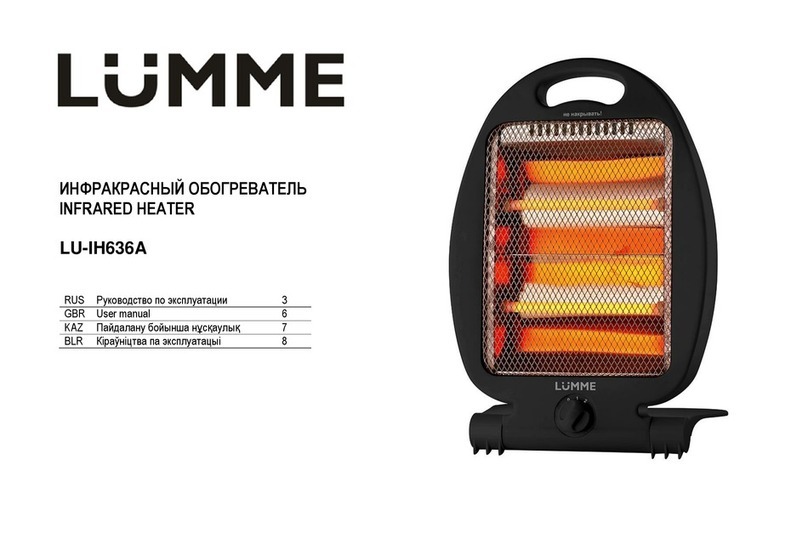
Lumme
Lumme LU-IH636A user manual
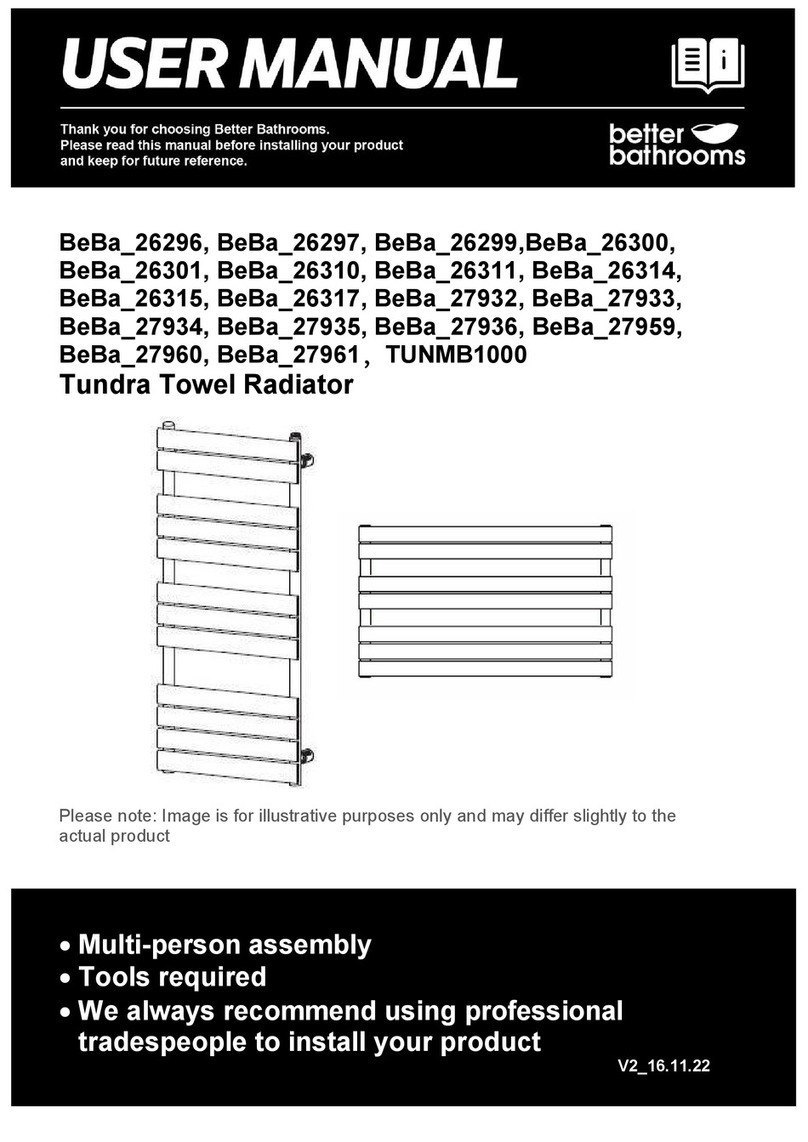
Better Bathrooms
Better Bathrooms Tundra BeBa-26296 manual
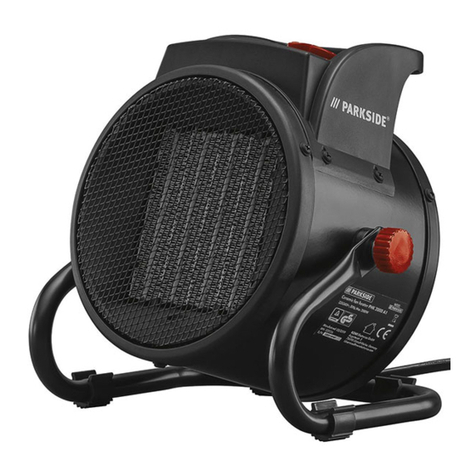
Parkside
Parkside PKH 2000 A1 Operation and safety instructions
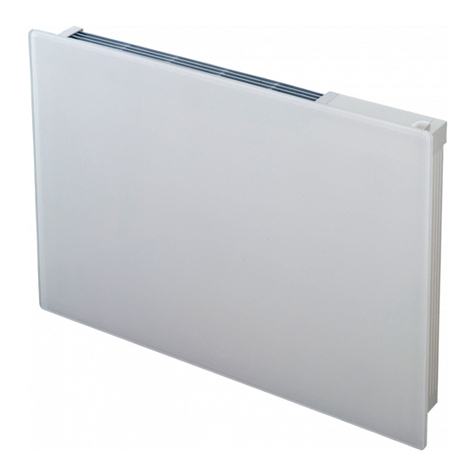
Dimplex
Dimplex GFP200 W Installation and operating instructions
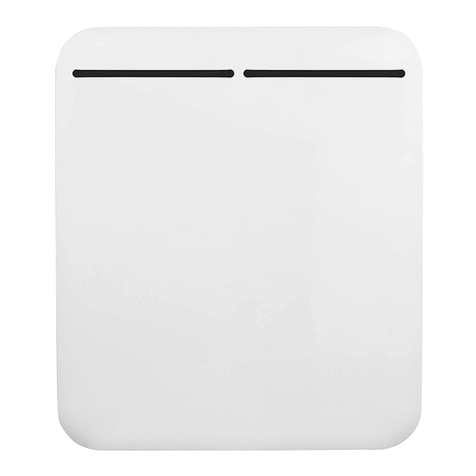
Mylek
Mylek MYH03-05E instruction manual
